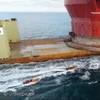The U.S. Navy’s investigator into the collision of a nuclear submarine and a Japanese fishing vessel testified on Tuesday that the presence of three civilians at the ship’s controls had nothing to do with the accident in which nine people died. Investigator Rear Adm. Charles Griffiths Jr., testifying on the second day of the official Court of Inquiry, said, “In my professional judgment, they had zero impact on the collision. They were merely acting at the direction of the watch standers (crew members).”
He said that the civilians at the controls of the USS Greeneville on Feb. 9., the day it rammed and sank the Japanese fishing training vessel the Ehime Maru, were a woman at the control of the ship’s Klaxon bell which sounds an alarm during emergency maneuvers, a man at the ballast control and another man directing the rudder.
Griffiths said they posed no problems as each had a crew member standing over their shoulders with hands on the controls as well. But he added that the presence of 16 civilians on a VIP tour of the sub may have posed a “passive” physical obstruction to the crew.
On Monday, Griffiths said that the crew of the USS Greeneville operated with a key piece of broken equipment, rushed through an emergency surfacing maneuver because lunch for the VIPs had taken too long and apparently ignored a sign that they were on a collision course with the Ehime Maru.
He said the Greeneville was on a day-long mission intended predominantly to show off the submarine to 16 civilian VIPs and was running 45 minutes behind schedule after the guests had to eat lunch in shifts because the mess room held only 10 people.
“I have a statement from the officer of the deck (Coen) that indicates the captain wanted to be at periscope depth in five minutes,” Griffiths said, adding that it normally takes at least about 10 minutes of searches to do an adequate job.
“That would imply he wanted to get to periscope depth in a hurry and I can surmise that’s because they were late.”
Once the Greeneville reached that depth, he said, its officers should have spent several minutes scanning the horizon. Instead they used the periscope for only about 80 seconds and missed the Ehime Maru, which was less than 2,000 feet (600 meters) away at that point.
Griffiths said that a key piece of equipment called a sonar repeater was found to be broken during the morning of the mission. One of the ship’s sonars was being operated by a trainee, the admiral said, but a senior sonar operator who should have been continually supervising him was busy acting as a tour guide instead.
Griffiths said one crew member, a fire control technician, failed to notify his superiors of the oncoming vessel partly because civilians were standing in his way and partly because Waddle was relying on other sonar operators for his information.
“Part of it was the physical barriers (of the civilians) and part of it was feeling that he had been benched in the game,” Griffiths said. Returning to that point in his Tuesday testimony, Griffiths was asked if he felt the crew could speak up and shout things out.
He said, “Because I am so perplexed that did not happen with the fire control officer .... I can only ponder that question. It is very disturbing that did not happen. It is one case where it could have made a difference.”
The admiral concluded that after tracking the Ehime Maru for over an hour before the collision, the crew of the Greeneville had no idea that it was less than 2,000 feet away when they started the emergency surfacing maneuver off Diamond Head near Honolulu. — (Reuters)
Sponsored Content
Innovative Hull Maintenance: Profitable & Green

Subscribe for
Maritime Reporter E-News
Maritime Reporter E-News is the maritime industry's largest circulation and most authoritative ENews Service, delivered to your Email five times per week













